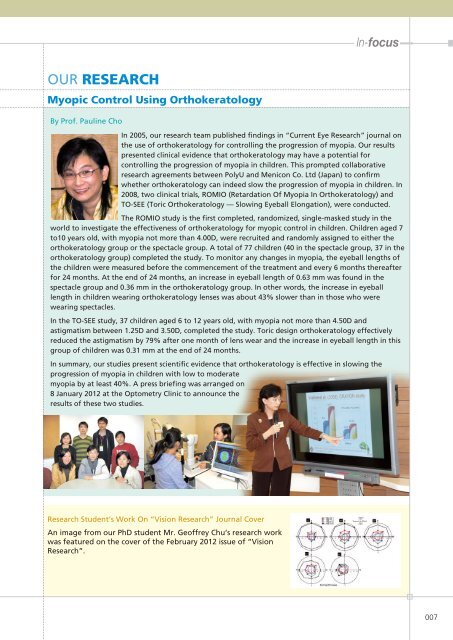醫療券 - The Hong Kong Polytechnic University
醫療券 - The Hong Kong Polytechnic University
醫療券 - The Hong Kong Polytechnic University
You also want an ePaper? Increase the reach of your titles
YUMPU automatically turns print PDFs into web optimized ePapers that Google loves.
OUR RESEARCH<br />
Myopic Control Using Orthokeratology<br />
By Prof. Pauline Cho<br />
In 2005, our research team published findings in “Current Eye Research” journal on<br />
the use of orthokeratology for controlling the progression of myopia. Our results<br />
presented clinical evidence that orthokeratology may have a potential for<br />
controlling the progression of myopia in children. This prompted collaborative<br />
research agreements between PolyU and Menicon Co. Ltd (Japan) to confirm<br />
whether orthokeratology can indeed slow the progression of myopia in children. In<br />
2008, two clinical trials, ROMIO (Retardation Of Myopia In Orthokeratology) and<br />
TO-SEE (Toric Orthokeratology — Slowing Eyeball Elongation), were conducted.<br />
<strong>The</strong> ROMIO study is the first completed, randomized, single-masked study in the<br />
world to investigate the effectiveness of orthokeratology for myopic control in children. Children aged 7<br />
to10 years old, with myopia not more than 4.00D, were recruited and randomly assigned to either the<br />
orthokeratology group or the spectacle group. A total of 77 children (40 in the spectacle group, 37 in the<br />
orthokeratology group) completed the study. To monitor any changes in myopia, the eyeball lengths of<br />
the children were measured before the commencement of the treatment and every 6 months thereafter<br />
for 24 months. At the end of 24 months, an increase in eyeball length of 0.63 mm was found in the<br />
spectacle group and 0.36 mm in the orthokeratology group. In other words, the increase in eyeball<br />
length in children wearing orthokeratology lenses was about 43% slower than in those who were<br />
wearing spectacles.<br />
In the TO-SEE study, 37 children aged 6 to 12 years old, with myopia not more than 4.50D and<br />
astigmatism between 1.25D and 3.50D, completed the study. Toric design orthokeratology effectively<br />
reduced the astigmatism by 79% after one month of lens wear and the increase in eyeball length in this<br />
group of children was 0.31 mm at the end of 24 months.<br />
In summary, our studies present scientific evidence that orthokeratology is effective in slowing the<br />
progression of myopia in children with low to moderate<br />
myopia by at least 40%. A press briefing was arranged on<br />
8 January 2012 at the Optometry Clinic to announce the<br />
results of these two studies.<br />
Research Student’s Work On “Vision Research” Journal Cover<br />
An image from our PhD student Mr. Geoffrey Chu’s research work<br />
was featured on the cover of the February 2012 issue of “Vision<br />
Research”.<br />
In-focus<br />
007

















